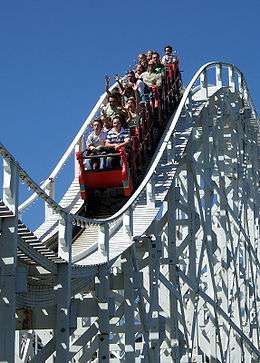Side friction roller coaster

A side friction roller coaster is an early roller coaster design that does not have an extra set of wheels under the track to prevent cars from becoming airborne. Before the invention of up-stop wheels, coaster cars were built to run in a trough, with wheels under the car and side plates to help keep the cars on the track. Because the cars were not firmly anchored and could derail if they took a corner too fast, the largest side friction coasters required a brakeman to ride on the train and slow it down when necessary.
The invention of up-stop wheels in the 1920s allowed much more scope for height and speed in coaster designs, leaving side friction coasters to quickly fall out of favor. Only two have been built since World War II, and none since 1951. Today, there are only nine left in the world. Seven of them are located in Europe, one in Australia, and one in North America. A tenth one that had been "standing but not operating,(SBNO)" since 2003, the "Runaway Coaster" at the defunct Rotunda Amusement Park in Kent, England, was demolished on April 5, 2007.
Installations
- Leap the Dips at Lakemont Park in Altoona, Pennsylvania. Opened in 1902, Leap the Dips is the oldest roller coaster in the world and the last remaining side-friction roller coaster in North America. It was out of service from 1985 to 1999.[1]
- Rutschebanen (the name literally means "The Roller Coaster") at Tivoli Gardens in Denmark. Built by Denmark native Valdemar Lebech. Opened in 1914.
- The Scenic Railway at Dreamland Margate in Kent, England. Opened in 1920, The Scenic Railway was granted Grade II listed status in the UK by English Heritage – the US equivalent of a national historic landmark. It has been standing but not operating (SBNO) since 2008, when a portion of the ride was destroyed in a fire.[2] However, the Scenic Railway has undergone restoration and Dreamland is reopening on 19 June 2015 following an £18m investment.[3]
- The scenic railway ride at Luna Park, Melbourne. It has been running since 1912, is the oldest continuously operating roller coaster in the world, and the oldest in Australia.
- The Hullámvasút at Vidámpark in Budapest, Hungary. Built in 1922, opened in 1926, after it was set on fire, this is the oldest operating roller coaster in Central Europe.
- The "Montaña Suiza" ("Swiss Mountain" in Spanish) at Parque de atracciones Monte Igueldo in Donostia-San Sebastián, Spain. Built by Erich Heidrich and operating since 1928.
- The Roller Coaster at Great Yarmouth Pleasure Beach in Norfolk, England. Also built by Erich Heidrich for the Colonial Exhibition in Paris in 1929. Moved to Great Yarmouth in 1932.
- Rutschebanen (the name literally means "The Roller Coaster") at Dyrehavsbakken in Denmark. Built by Denmark native Valdemar Lebech. Opened in 1932.
- The Hochschaubahn at Wurstelprater in Vienna, Austria. Opened in 1950 as a replacement for the original, which was destroyed during World War II.
- Vuoristorata at Linnanmäki in Helsinki, Finland. Built by Denmark native Valdemar Lebech. Opened in 1951. To date, this is the last side friction coaster ever built.
References
| Wikimedia Commons has media related to Side friction roller coasters. |
- ↑ Todd W. Fornwalt (2010). "Leap-the-Dips: A Thrill From the Past". Penn State University. Retrieved May 14, 2015.
- ↑ "Fire rips through rollercoaster". BBC News. April 7, 2008. Retrieved May 14, 2015.
- ↑ http://www.bbc.co.uk/news/uk-england-kent-32082943